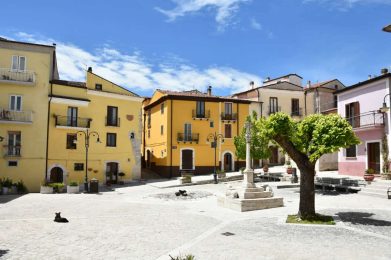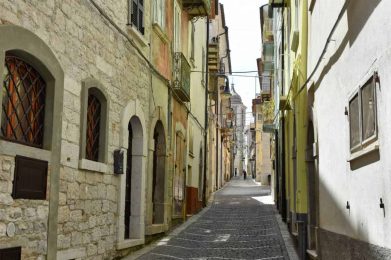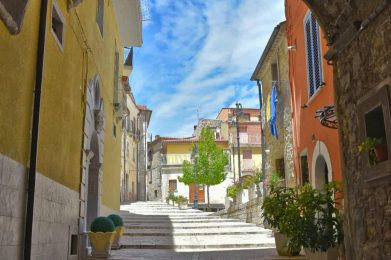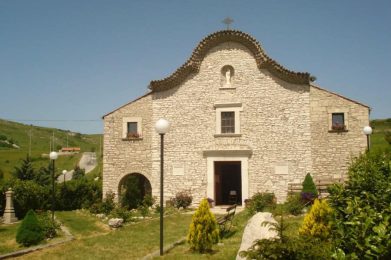An evocative Molise village, in the province of Isernia, which still retains its ancient medieval urban charm. The landscape of Frosolone is truly fascinating. Located in a promontory surrounded by steep cliffs, hills, woods, pastures and ponds, Frosolone is characterized by a morphology of carbonate rocks with bizarre and surprising shapes. The country today is a very active center in the craft sector and, in particular, in the production of scissors and knives.
Immagini del borgo
In the heart of the Molise Apennines, amid undulating pastures and dense forests, lies Frosolone, one of the most charming villages in the region. Located at an altitude of about 900 meters in the Upper Molise region, Frosolone is a town with a long and noble history, known throughout Italy for the centuries-old art of scissor and knife making, now celebrated in the local Museo dei Ferri Taglienti, which collects period craft tools and tells the identity of a community linked to savoir-faire.
An ancient and evocative past
The origins of Frosolone are lost in history: according to some scholars, it corresponds to ancient Fresilia, a Samnite city subdued by the Romans in 304 BC. Traces of this past are visible in the evocative remains of megalithic walls, called “pelasgic walls,” at Castellone and Civitella, silent witnesses of a remote era.
The first official records date back to the 11th century, a period when Frosolone was part of the County of Isernia. In the following centuries it was involved in a complex web of dominations: from the Lombards to the Normans, until it became part of the County of Molise. This composite past has left a visible imprint in the urban fabric and architecture of the village.
Architecture and places of interest
To stroll through the historic center of Frosolone is to immerse oneself in an authentic atmosphere, among cobblestone alleys, ancient buildings and churches rich in art. The Church of Santa Maria Assunta stands out, with its elegant Baroque facade and precious interior enriched with 18th-century paintings and a silver crucifix. Also worth a visit are the Church of Santa Maria delle Grazie, with a wooden altar adorned with paintings, and the unique hexagonal Church of St. Anthony of Padua.
Among the civic architecture, notable is the 16th-century mansion house with loggia, and the picturesque “shepherd’s cottage,” a faithful reproduction of rural life of yesteryear. Opposite the center, the public washhouse with a 19th-century fountain is another charming corner where time seems to stand still.
Nature and outdoor activities
The landscape surrounding Frosolone is an invitation to experience nature in all seasons. The Montagnola plateau, part of Molise’s Frassati Trail, offers spectacular scenery and trails perfect for trekking, trail and sport climbing. The hermitage of Sant’Egidio and the small church on Gonfalone Hill, which can also be reached by car, offer quiet moments and unforgettable views.
The centuries-old forests of Mount Marchetta, Bear Hill and the Grisciata Forest are home to majestic beech forests and rich biodiversity, with wild blooms of cyclamen, snowdrops and prized mycological species. Here it is possible to encounter foxes, wild boars, birds of prey and, in some cases, even the Apennine wolf.
Culture, rituals and gastronomy
Folk traditions are alive and deep-rooted in Frosolone. Particularly heartfelt is the feast of St. Anthony the Abbot, with the characteristic blessing of animals. Equally evocative is the celebration of the ancient transhumance, which commemorates the passage of herds from Puglia to Frosolone led by the historic Colantuono Family, one of the last to practice it to this day.
Two not-to-be-missed events are the “National Exhibition of Scissors and Knives”, a showcase of local craftsmanship excellence, and the “August 1 Parade of Carts,” a colorful event that enlivens the streets of the town with scenic representations of peasant life, amid irony, memory and creativity.
From a gastronomic point of view, Frosolone offers a simple but intense cuisine, made up of peasant dishes such as “petacce e fasciuole” (handmade pasta with beans) and excellent cheeses. Prominent among these is manteca, a string cheese with a buttery heart, celebrated every summer with a festival in the hamlet of Acquevive.
A village for every season
Frosolone is the ideal destination for those seeking authenticity, nature and tradition. Whether you are a history buff, sportsman, gourmet or simple traveler in search of silence and beauty, this Molise village will surprise you with its strong and gentle soul, made of stone, wind, industrious hands and ancient knowledge.
Village of Frosolone
Municipality of Frosolone
Province of Isernia
Molise Region
Inhabitants: 3.172 frosolonesi
Center Altitude: 894 m s.l.m.
The Municipality is part of:
I Borghi più belli d’Italia
Città dei sapori
Paesi bandiera arancione
Acknowledgments
Orange Flag – Italian Touring Club
Municipality
Corso Garibaldi 37 – Tel. 0874-890435
BY CAR
- From the North: Take the A14 Adriatica highway, exit at Montenero di Bisaccia / Vasto Sud / San Salvo, take the SS 650 (Fondo Valle Trigno) in the direction of Isernia, turn in the direction of Civitanova del Sannio, continue along the SP 74 towards Frosolone.
- From the south: Autostrada Adriatica A14, follow the direction of Pescara, continue on the A16 motorway, follow the direction of Benevento, in Benevento continue on the SS 88, exit at Campobasso, take the SS 87 (Bifernina state road) towards Campobasso / Isernia, continue on the SS 17, SS 618 in the direction of Frosolone.
- From Isernia: Take the SS 85, continue on the SS 17 in the direction of Campobasso, take the SS 618 in the direction of Frosolone.
- From Campobasso: Take the SS 87 (Bifernina state road), continue on the SS 647 dir B, SS 647, continue on the SP 169, SS 618 in the direction of Frosolone.
- From Naples: Take the A1 Rome – Naples highway, exit at Caianello, follow the signs for Isernia, SS 85, continue on the SS 17 in the direction of Campobasso, cross Isernia, take the SS 618 in the direction of Frosolone.
- From Rome: From the A1 Autostrada del Sole exit at San Vittore, follow the direction Venafro on the SS 6, in Venafro continue on the SS 85 in the direction of Isernia, continue on the SS 17 in the direction of Campobasso, cross Isernia, take the SS 618 in direction of Frosolone.
ON THE TRAIN
- Isernia railway station
BY PLANE
- Naples airport
- Foggia airport
- Pescara airport
- Rome Ciampino Airport
- Rome Fiumicino Airport
BY SEA
- Port of Termoli
- Port of Naples
- August – National Show of Scissors and Knives. Important showcase and meeting point of the best Italian artisans.
- December – Truffles & Molise. Show-market of premium white truffle (Tuber magnatum).







